
The merger of dbt Labs and Fivetran (which we refer to as dbt Fivetran for simplicity) represents a new era in enterprise analytics. The combined company is expected to create a streamlined, end-to-end data workflow consolidating data ingestion, transformation, and activation with the stated goal of reducing operational overhead and accelerating delivery. Yet, at the dbt Coalesce conference in October 2025 and in ongoing conversations with data leaders, many are voicing concerns about price uncertainty, reduced flexibility, and the long-term future of dbt Core.
As enterprises evaluate the implications of this merger, understanding both the opportunities and risks is critical for making informed decisions about their organization's long-term analytics strategy.
In this article, you’ll learn:
1. What benefits could the dbt Fivetran merger offer enterprise data teams
2. Key risks and lessons from past open-source acquisitions
3. How enterprises can manage risks and challenges
4. Practical steps dbt Fivetran can take to address community anxiety
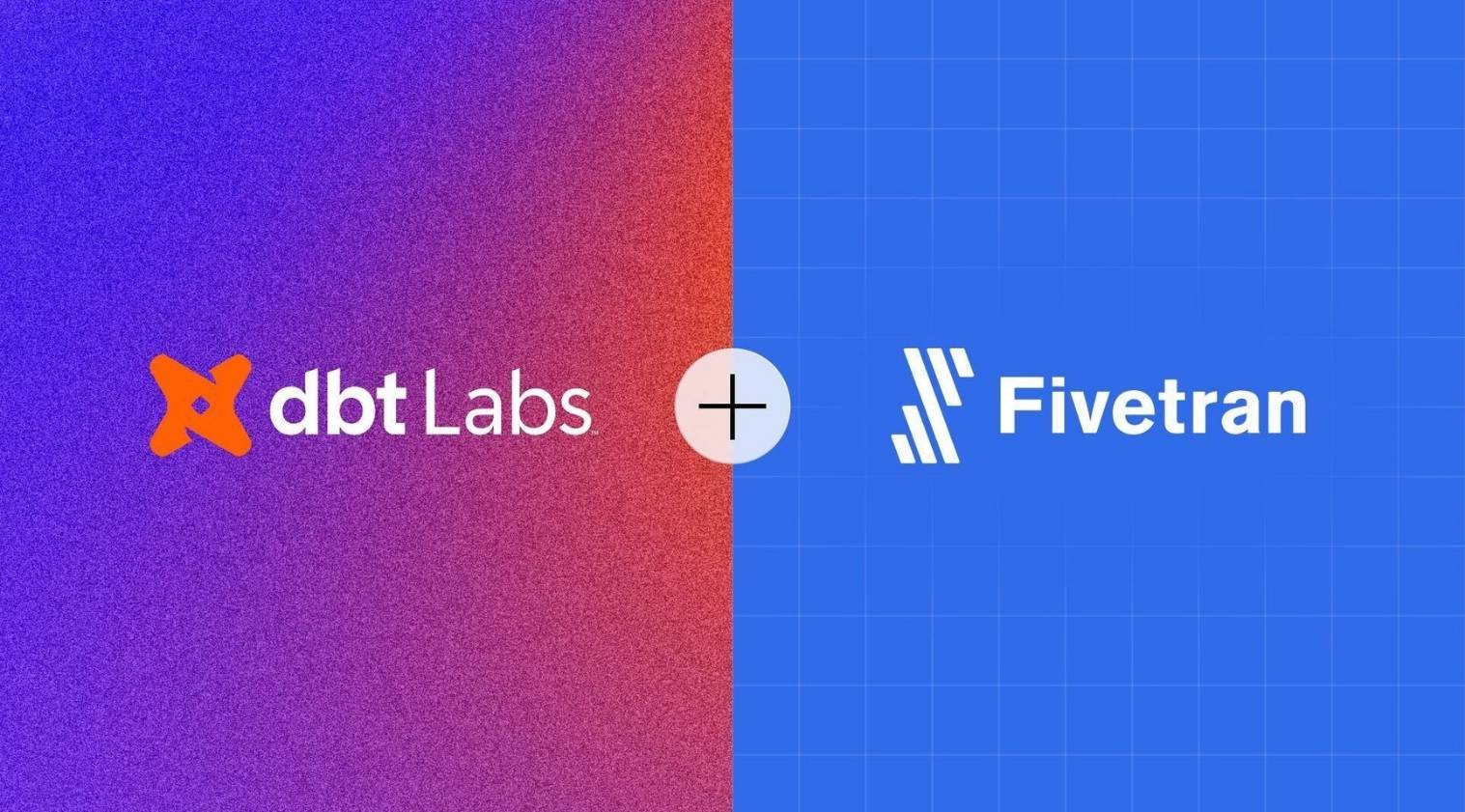
For enterprise data teams, the dbt Fivetran merger may bring compelling opportunities:
1. Integrated Analytics Stack:
The combination of ingestion, transformation, and activation (reverse ETL) processes may enhance onboarding by streamlining contract management, security evaluations, and user training.
2. Resource Investment:
The merged company has the potential to speed up feature development across the data landscape. Open data standards like Iceberg could see increased adoption, fostering interoperability between platforms such as Snowflake and Databricks.
While these prospects are enticing, they are not guaranteed. The newly formed organization now faces the non-trivial task of merging various teams, including Fivetran, HVR (Oct 2021), Census (May 2025), SQLMesh/Tobiko (Sept 2025), and dbt Labs (Oct 2025). Successfully integrating their tools, development practices, and support functions will be crucial. To create a truly seamless, end-to-end platform, alignment of product roadmaps, engineering standards, and operational processes will be necessary. Enterprises should carefully assess the execution risks when considering the promised benefits of this merger, as these advantages hinge on Fivetran's ability to effectively integrate these technologies and teams.
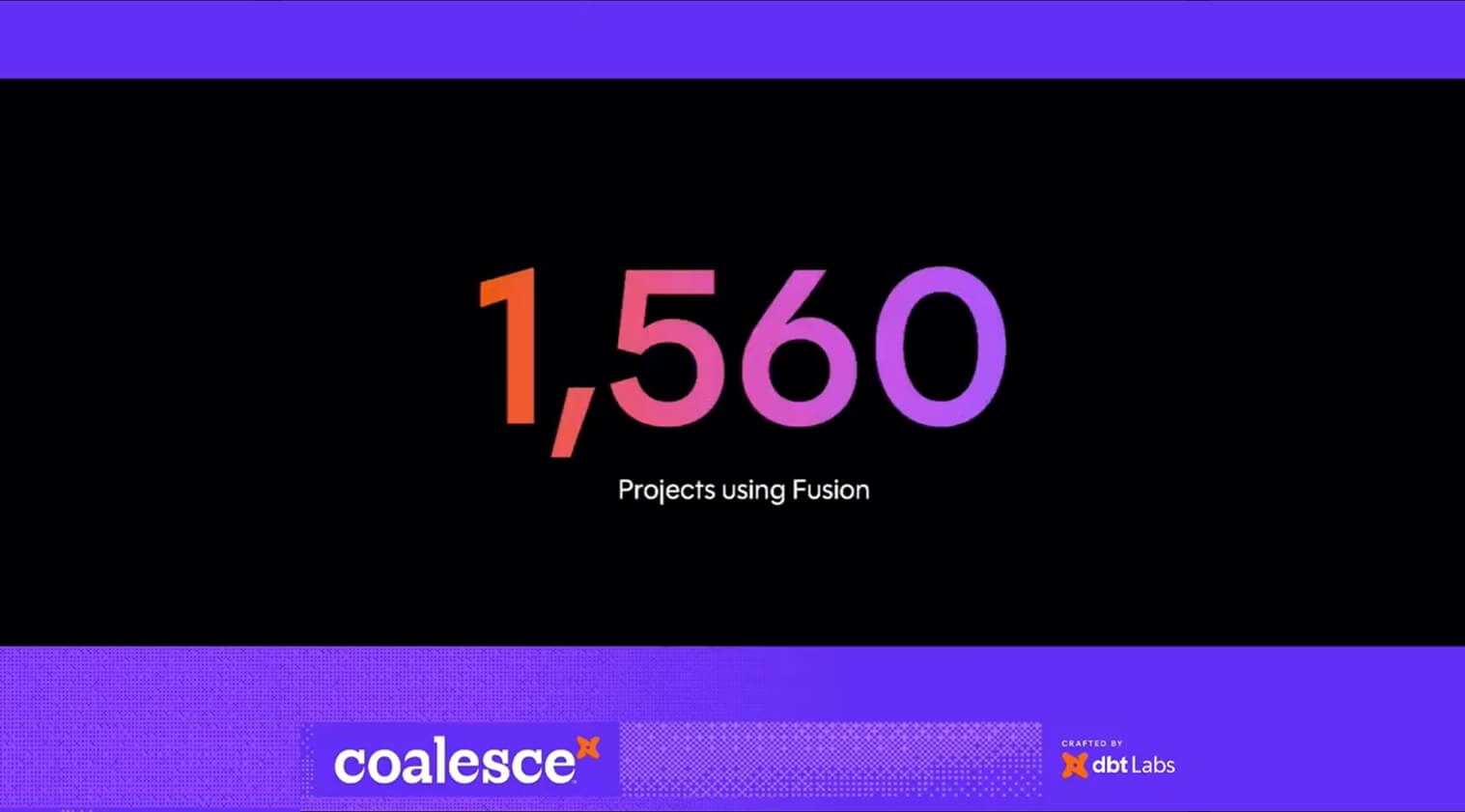
The future openness and flexibility of dbt Core is being questioned, with significant consequences for enterprise data teams that rely on open-source tooling for agility, security, and control.
dbt’s rapid adoption, now exceeding 80,000 projects, was fueled by its permissive Apache License and a vibrant, collaborative community. This openness allowed organizations to deploy, customize, and extend dbt to fit their needs, and enabled companies like Datacoves to build complementary tools, sponsor open-source projects, and simplify enterprise data workflows.
However, recent moves by dbt Labs, accelerated by the Fivetran merger, signal a natural evolution toward monetization and enterprise alignment:
1. Licensing agreement with Snowflake
2. Rewriting dbt Core as dbt Fusion under a more restrictive ELv2 license
3. Introducing a “freemium” model for the dbt VS Code Extension, limiting free use to 15 registered users per organization

While these steps are understandable from a business perspective, they introduce uncertainty and anxiety within the data community. The risk is that the balance between open innovation and commercial control could tip, raising understandable questions about long-term flexibility that enterprises have come to expect from dbt Core.
dbt Labs and Fivetran have both stated that dbt Core's license would not change, and I believe them. The vast majority of dbt users are using dbt Core and changing the licenses risks fragmentation and loss of goodwill in the community. The future vision for dbt is not dbt Core, but instead dbt Fusion.
While I see a future for dbt Core, I don't feel the same about SQLMesh. There is little chance that the dbt Fivetran organization would continue to invest in two open-source projects. It is also unlikely that SQLMesh innovations would make their way into dbt Core, as that would directly compete with dbt Fusion.
Recent history offers important cautionary tales for enterprises. While not a direct parallel, it’s worth learning from:
1. Terraform: A license change led to fragmentation and the creation of OpenTofu, eroding trust in the original steward.
2. ElasticSearch: License restrictions resulted in the OpenSearch fork, dividing the community and increasing support risks.
3. Redis and MongoDB: Similar license shifts caused forks or migrations to alternative solutions, increasing risk and migration costs.
For enterprise data leaders, these precedents highlight the dangers of vendor fragmentation, increased migration costs, and uncertainty around long-term support. When foundational tools become less open, organizations may face difficult decisions about adapting, migrating, or seeking alternatives. If you're considering your options, check out our Platform Evaluation Worksheet.
On the other hand, there are successful models where open-source projects and commercial offerings coexist and thrive:
1. Airflow: Maintains a permissive license, with commercial providers offering managed services and enterprise features.
2. GitLab, Spark, and Kafka: Each has built a sustainable business around a robust open-source core, monetizing through value-added services and features.
These examples show that a healthy open-source core, supported by managed services and enterprise features, can benefit all stakeholders, provided the commitment to openness remains.
To navigate the evolving landscape, enterprises should:
1. Monitor licensing and governance changes closely.
2. Engage in community and governance discussions to advocate for transparency.
3. Plan for contingencies, including potential migration or multi-vendor strategies.
4. Diversify by avoiding over-reliance on a single vendor or platform.
Avoid Vendor Lock-In:
1. Continue to leverage multiple tools for data ingestion and orchestration (e.g., Airflow) instead of relying solely on a single vendor’s stack.
2. Why? This preserves your ability to adapt as technology and vendor priorities evolve. While tighter tool integration is a potential promise of consolidation, options exist to reduce the burden of a multi-tool architecture.
For instance, Datacoves is built to help enterprises maintain governance, reliability, and freedom of choice to deploy securely in their own network, specifically supporting multi-tool architectures and open standards to minimize vendor lock-in risk.
Demand Roadmap Transparency:
1. Engage with your vendors about their product direction and advocate for community-driven development.
2. Why? Transparency helps align vendor decisions with your business needs and reduces the risk of disruptive surprises.
Participate in Open-Source Communities:
1. Contribute to and help maintain the open-source projects that underpin your data platform.
2. Why? Active participation ensures your requirements are heard and helps sustain the projects you depend on.
Attend and Sponsor Diverse Conferences:
1. Support and participate in community-driven events (such as Airflow Summit) to foster innovation and avoid concentration of influence.
2. Why? Exposure to a variety of perspectives leads to stronger solutions and a healthier ecosystem.
Support OSS Creators Financially and Through Advocacy:
1. Sponsor projects or directly support maintainers of critical open-source tools.
2. Why? Sustainable funding and engagement are vital for the health and reliability of the open-source ecosystem.
Encourage Openness and Diversity
1. Champion Diversity in OSS Governance: Advocate for broad, meritocratic project leadership and a diverse contributor base.
2. Why? Diverse stewardship drives innovation, resilience, and reduces the risk of any one entity dominating the project’s direction.
Long-term analytics success isn’t just about technology selection. It’s about actively shaping the ecosystem through strategic diversification, transparent vendor engagement, and meaningful support of open standards and communities. Enterprises that invest in these areas will be best equipped to thrive, no matter how the vendor landscape evolves.
While both dbt Labs and Fivetran have stated that the dbt Core license would remain permissive, to preserve trust and innovation in the data community, dbt Fivetran should commit to neutral governance and open standards for dbt Core, ensuring it remains a true foundation for collaboration, not fragmentation.
It is common knowledge that the dbt community has powered a remarkable flywheel of innovation, career growth, and ecosystem expansion. Disrupting this momentum risks technical fragmentation and loss of goodwill, outcomes that benefit no one in the analytics landscape.
To maintain community trust and momentum, dbt Fivetran should:
1. Establish Neutral Governance:
Place dbt Core under independent oversight, where its roadmap is shaped by a diverse set of contributors, not just a single commercial entity. Projects like Iceberg have shown that broad-based governance sustains engagement and innovation, compared to more vendor-driven models like Delta Lake.
2. Consider Neutral Stewardship Models:
One possible long-term approach that has been seen in projects like Iceberg and OpenTelemetry is to place an open-source core under neutral foundation governance (for example, the Linux Foundation or Apache Software Foundation).
While dbt Labs and Fivetran have both reaffirmed their commitment to keeping dbt Core open, exploring such models in the future could further strengthen community trust and ensure continued neutrality as the platform evolves.
3. Encourage Meritocratic Development: Empower a core team representing the broader community to guide dbt Core’s future. This approach minimizes the risk of forks and fragmentation and ensures that innovation is driven by real-world needs.
4. Apply Lessons from MetricFlow: When dbt Labs acquired MetricFlow and changed its license to BSL, it led to further fragmentation in the semantic layer space. Now, with MetricFlow relicensed as Apache and governed by the Open Semantic Interchange (OSI) initiative (including dbt Labs, Snowflake, and Tableau), the project is positioned as a vendor-neutral standard. This kind of model should be considered for dbt Core as well.
1. Technical teams: By ensuring continued access to an open, extensible framework, and reducing the risk of disruptive migration.
2. Business leaders: By protecting investments in analytics workflows and minimizing vendor lock-in or unexpected costs.
Solidifying dbt Core as a true open standard benefits the entire ecosystem, including dbt Fivetran, which is building its future, dbt Fusion, on this foundation. Taking these steps would not only calm community anxiety but also position dbt Fivetran as a trusted leader for the next era of enterprise analytics.
The dbt Fivetran merger represents a defining moment for the modern data stack, promising streamlined workflows while simultaneously raising critical questions about vendor lock-in, open-source governance, and long-term flexibility. Successfully navigating this shift requires a proactive, diversified strategy, one that champions open standards and avoids over-reliance on any single vendor. Enterprises that invest in active community engagement and robust contingency planning will be best equipped to maintain control and unlock maximum value from their analytics platforms.
If your organization is looking for a way to mitigate these risks and secure your workflows with enterprise-grade governance and multi-tool architecture, Datacoves offers a managed platform designed for maximum flexibility and control. For a deeper look, find out what Datacoves has to offer.
Ready to take control of your data future? Contact us today to explore how Datacoves allows organizations to take control while still simplifying platform management and tool integration.
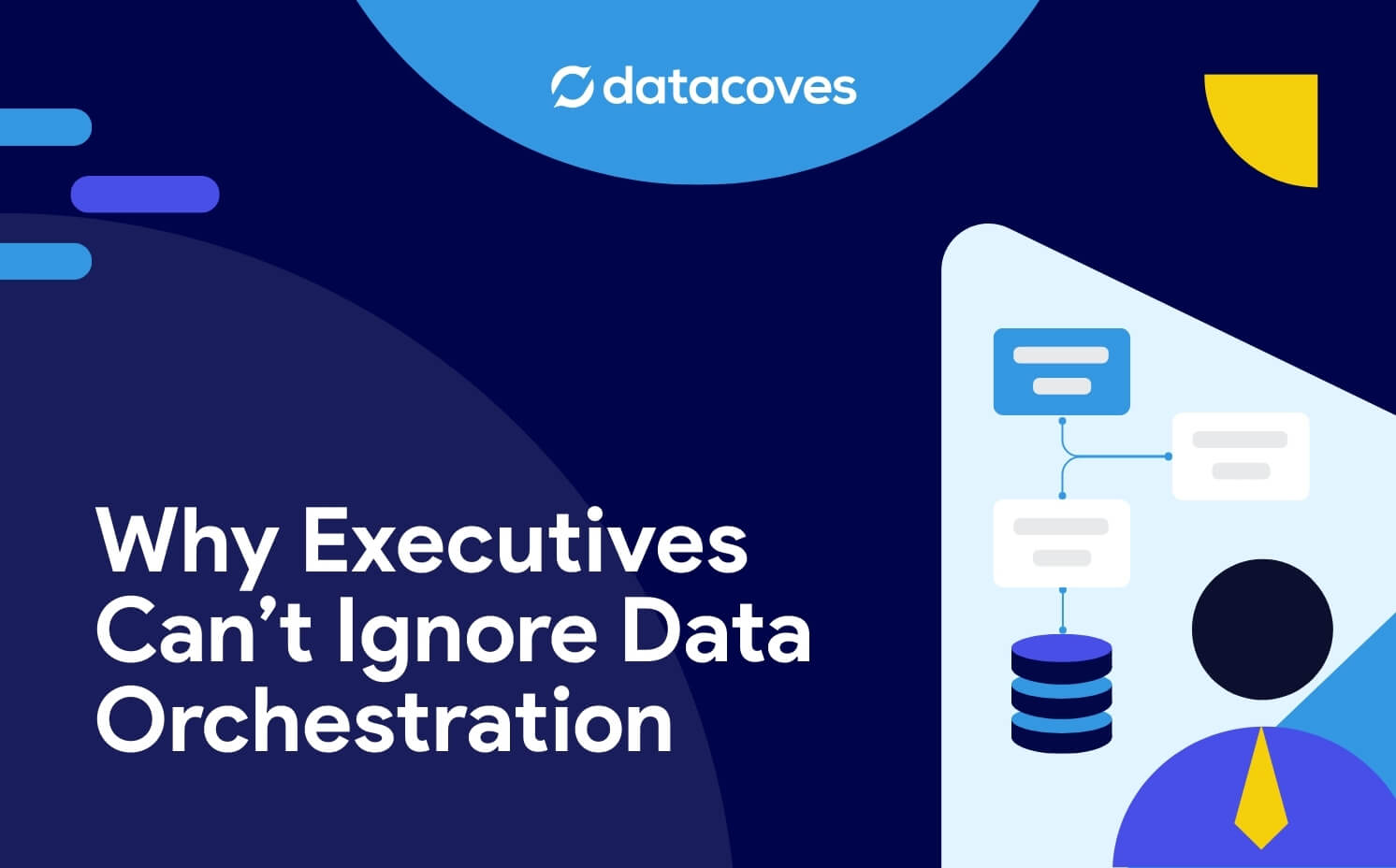
Data orchestration is the foundation that ensures every step in your data value chain runs in the correct order, with the right dependencies, and with full visibility. Without it, even the best tools such as dbt, Airflow, Snowflake, or your BI platform operate in silos. This disconnect creates delays, data fires, and unreliable insights.
For executives, data orchestration is not optional. It prevents fragmented workflows, reduces operational risk, and helps teams deliver trusted insights quickly and consistently. When orchestration is built into the data platform from the start, organizations eliminate hidden technical debt, scale more confidently, and avoid the costly rework that slows innovation.
In short, data orchestration is how modern data teams deliver reliable, end-to-end value without surprises.
In today’s fast-paced business environment, executives are under increased pressure to deliver quick wins and measurable results. However, one capability that is often overlooked is data orchestration.
This oversight can sabotage progress as the promise of data modernization efforts fails to deliver expected outcomes in terms of ROI and improved efficiencies.
In this article, we will explain what data orchestration is, the risks of not implementing proper data orchestration, and how executives benefit from end-to-end data orchestration.
Data orchestration ensures every step in your data value chain runs in the right order, with the right dependencies, and with full visibility.
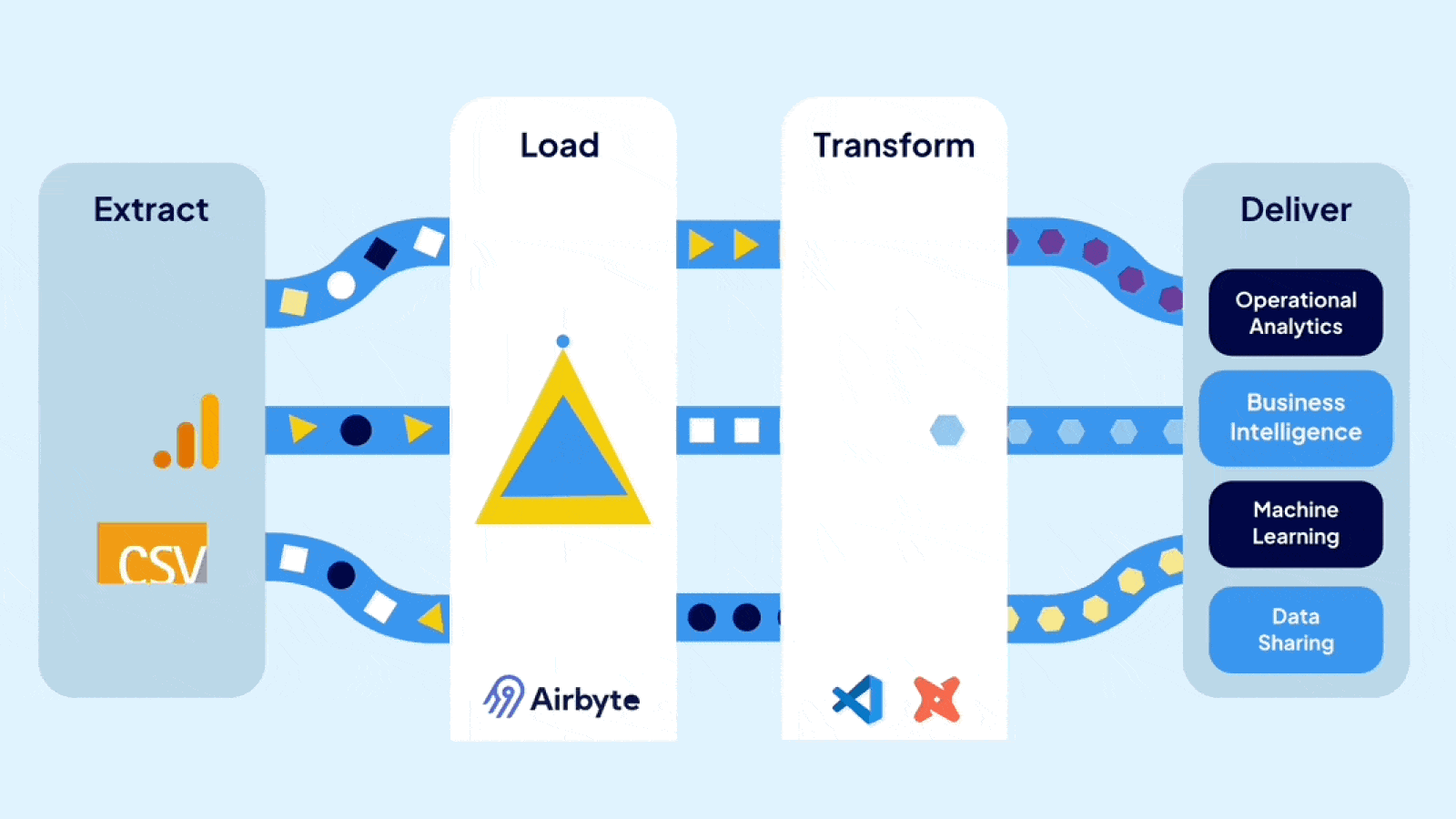
Data orchestration is the practice of coordinating all the steps in your organization’s data processes so they run smoothly, in the right order, and without surprises. Think of it as the conductor ensuring each instrument plays at the right time to create beautiful music.
Generating insights is a multi-tool process. What’s the problem with this setup? Each of these tools may include its own scheduler, and they will each run in a silo. Even if an upstream step fails or is delayed, the subsequent steps will run. This disconnect leads to surprises for executives expecting trusted insights. This in turn, leads to delays and data fires, which are disruptive and inefficient for the organization.
Imagine you are baking a chocolate cake. You would need a recipe, all the ingredients, and a functioning oven. However, you wouldn’t turn on the oven before buying the ingredients and mixing the batter if your milk had spoiled. Not having someone orchestrating all the steps in the right sequence would lead to a disorganized process that is inefficient and wasteful. You also know not to continue if there is a critical issue, such as spoiled milk.
Data orchestration solves the problem of having siloed tools by connecting all the steps in the data value chain. This way, if one step is delayed or fails, subsequent steps do not run. With a data orchestration tool, we can also notify someone to resolve the issue so they can act quickly, reducing fires and providing visibility to the entire process.
ETL (Extract, Transform, and Load) focuses on moving and transforming data, but data orchestration is about making sure everything happens in the right sequence across all tools and systems. It’s the difference between just having the pieces of a puzzle and putting them together into a clear picture.
Without data orchestration, even the best tools operate in silos, creating delays, data fires, and unreliable insights.
Executives make many decisions but rarely have the time to dive into technical details. They delegate research and expect quick wins, which often leads to mixed messaging. Leaders want resilient, scalable, future-proof solutions, yet they also pressure teams to deliver “something now.” Vendors exploit this tension. They sell tools that solve one slice of the data value chain but rarely explain that their product won't fix the underlying fragmentation. Quick wins may ship, but the systemic problems remain.
Data orchestration removes this friction. When workflows are unified, adding steps to the data flow is straightforward, pipelines are predictable, and teams deliver high-quality data products faster and with far fewer surprises.
A major Datacoves customer summarized the difference clearly:
“Before, we had many data fires disrupting the organization. Now issues still occur, but we catch them immediately and prevent bad data from reaching stakeholders.”
Without orchestration, each new tool adds another blind spot. Teams don’t see failures until they hit downstream systems or show up in dashboards. This reactive posture creates endless rework, late-night outages, and a reputation problem with stakeholders.
With orchestration, failures surface early. Dependencies, quality checks, and execution paths are clear. Teams prevent incidents instead of reacting to them.
Data orchestration isn’t just about automation; it’s about governance.
It ensures:
This visibility dramatically improves trust. Stakeholders no longer get “chocolate cake” made with spoiled milk. A new tool may bake faster, but if upstream data is broken, the final product is still compromised.
Orchestration ensures the entire value chain is healthy, not just one ingredient.
Modern data teams rely heavily on tools like dbt and Airflow, but these tools do not magically align themselves. Without orchestration:
With orchestration in place, ingestion, dbt scheduling, and activation become reliable, governed, and transparent, ensuring every step runs at the right time, in the right order, with the right dependencies. Learn more in our guide on the difference between dbt Cloud vs dbt Core.
For more details on how dbt schedules and runs models, see the official dbt documentation.
To learn how Airflow manages task dependencies and scheduling, visit the official Apache Airflow documentation.
It is tempting to postpone data orchestration until the weight of data problems makes it unavoidable. Even the best tools and talented teams can struggle without a clear orchestration strategy. When data processes aren’t coordinated, organizations face inefficiencies, errors, and lost opportunities.
Implementing data orchestration early reduces hidden technical debt, prevents rework, and helps teams deliver trusted insights faster.
When data pipelines rely on multiple systems that don’t communicate well, teams spend extra time manually moving data, reconciling errors, and firefighting issues. This slows decision-making and increases operational costs.
Common symptoms of fragmented tools include:
Many organizations focus on a “quick wins” approach only to discover that the cost of moving fast was long-term lack of agility and technical debt. This approach may deliver immediate results but leads to technical debt, wasted spend, and fragile data processes that are hard to scale. A great example is Data Drive’s journey, before adding data orchestration, when issues occurred, they had to spend time debugging each step of their disconnected process. Now it is clear where an issue has occurred, enabling them to resolve issues faster for their stakeholders.
As organizations grow, the absence of orchestration forces teams to revisit and fix processes repeatedly. Embedding orchestration from the start avoids repeated firefighting, accelerates innovation, and makes scaling smoother. Improving one step alone cannot deliver the desired outcome, just like a single egg cannot make a cake.
Organizations without data orchestration are effectively flying blind. Disconnected processes run out of order and issues are discovered by frustrated stakeholders. Resource-constrained data teams spend their time firefighting instead of delivering new insights. The result is delays in decision-making, higher operating costs, and an erosion of trust in data. Embedding orchestration from the start avoids repeated firefighting, accelerates innovation, and makes scaling smoother.
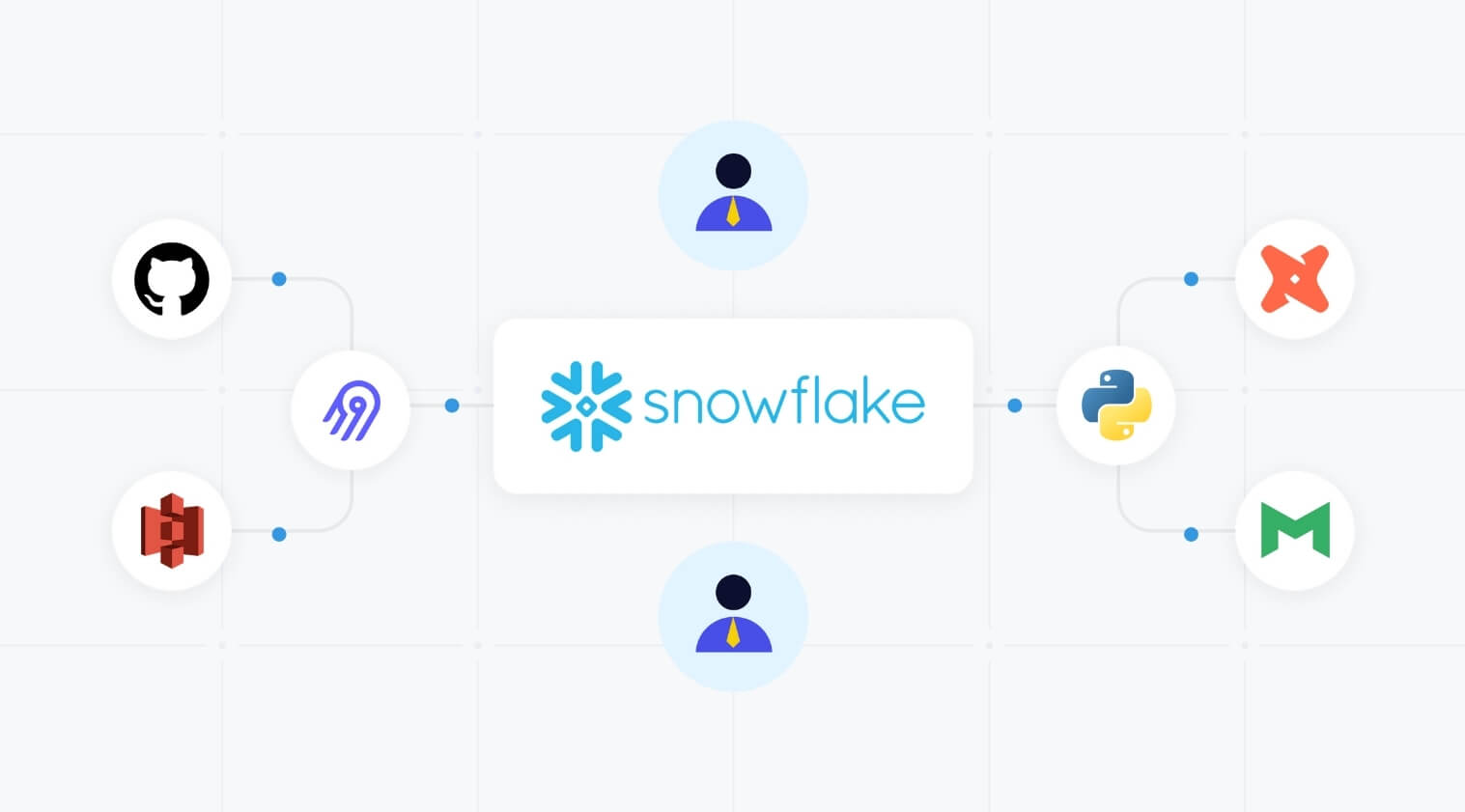
If data orchestration is so important, why do organizations go without it? We often hear some common objections:
Many organizations have not heard of data orchestration and tool vendors rarely highlight this need. It’s only after a painful experience that they realize this essential need.
It’s true that data orchestration adds another layer, but without it, you have disconnected, siloed processes. The real cost comes from chaos, not from coordination.
Vendor sprawl can indeed introduce additional risks, that’s why all-in-one platforms like Datacoves reduce integration overhead by bundling enterprise-grade orchestration, like Airflow, without increasing vendor lock-in. Explore Datacoves’ Integrated Orchestration Platform.
Data value chains are inherently complex, with multiple data sources, ingestion processes, transformations, and data consumers. Data orchestration does not introduce complexity; it provides visibility and control over this complexity.
It may seem reasonable to postpone data orchestration in the short term. But every mature data organization, both large and small, eventually needs to scale. By building-in data orchestration into the data platform from the start, you set up your teams for success, reduce firefighting, and avoid costly and time-consuming rework. Most importantly, the business receives trustworthy insights faster.
Implementing data orchestration doesn’t have to be complicated. The key is to approach it strategically, ensuring that every process is aligned, visible, and scalable.
Begin by mapping your existing data processes and identifying where inefficiencies or risks exist. Knowing exactly how data flows across teams and tools allows you to prioritize the areas that will benefit most from orchestration.
Key outcomes:
Focus first on automating repetitive and error-prone steps such as data collection, cleaning, and routing. Automation reduces manual effort, frees up your team for higher-value work, and ensures processes run consistently.
Key outcomes:
Implement dashboards or monitoring tools that provide executives and teams with real-time visibility into data flows. Early detection of errors prevents costly mistakes and increases confidence in the insights being delivered.
Key outcomes:
Start small with high-impact processes and expand orchestration across more workflows over time. Scaling gradually ensures that teams adopt the changes effectively and that processes remain manageable as data volume grows.
Key outcomes:
Select tools that integrate well with your existing systems, and provide flexibility for future growth. Popular orchestration tools include dbt and Airflow, but the best choice depends on your organization’s specific workflows and needs. Explore how these capabilities come packaged in the Datacoves Platform Features overview.
Key outcomes:
Investing in data orchestration delivers tangible business value. Organizations that implement orchestration gain efficiency, reliability, and confidence in their decision-making.
Data orchestration reduces manual work, prevents duplicated efforts, and streamlines processes. Teams can focus on higher-value initiatives instead of firefighting data issues.
With coordinated workflows and monitoring, executives and stakeholders can trust the data they rely on. Decisions are backed by accurate, timely, and actionable insights.
By embedding data orchestration early, organizations avoid expensive rework, reduce errors, and prevent the accumulation of technical debt from ad hoc solutions.
Data orchestration ensures that data pipelines scale smoothly as the organization grows. Teams can launch new analytics initiatives faster, confident that their underlying processes are robust and repeatable.
Executives gain a clear view of the entire data lifecycle, enabling better oversight, risk management, and strategic planning.
Data orchestration should not be seen as a “nice to have” feature that can be postponed. Mature organizations understand that it is the foundation needed to deliver trusted insights faster. Without it, companies risk setting up siloed tools, increased data firefighting, and eroding trust in both the data and the data team. With it, organizations gain visibility, agility, and the confidence that insights fueling decisions are accurate.
The real question for strategic leaders is whether to try to piece together disconnected solutions, focusing only on short-term wins, or invest in data orchestration early and unlock the full potential of a connected ecosystem.
For executives, prioritizing data orchestration will mean fewer data fires, accelerated innovation, and an environment where trusted insights flow as reliably as the business demands.
To see how orchestration is built into the Datacoves platform, visit our Integrated Orchestration page.
Don’t wait until complexity forces your hand. Your team deserves to move faster and fight fewer fires.
Book a personalized demo to see how data orchestration with Datacoves helps leaders unlock value from day one.
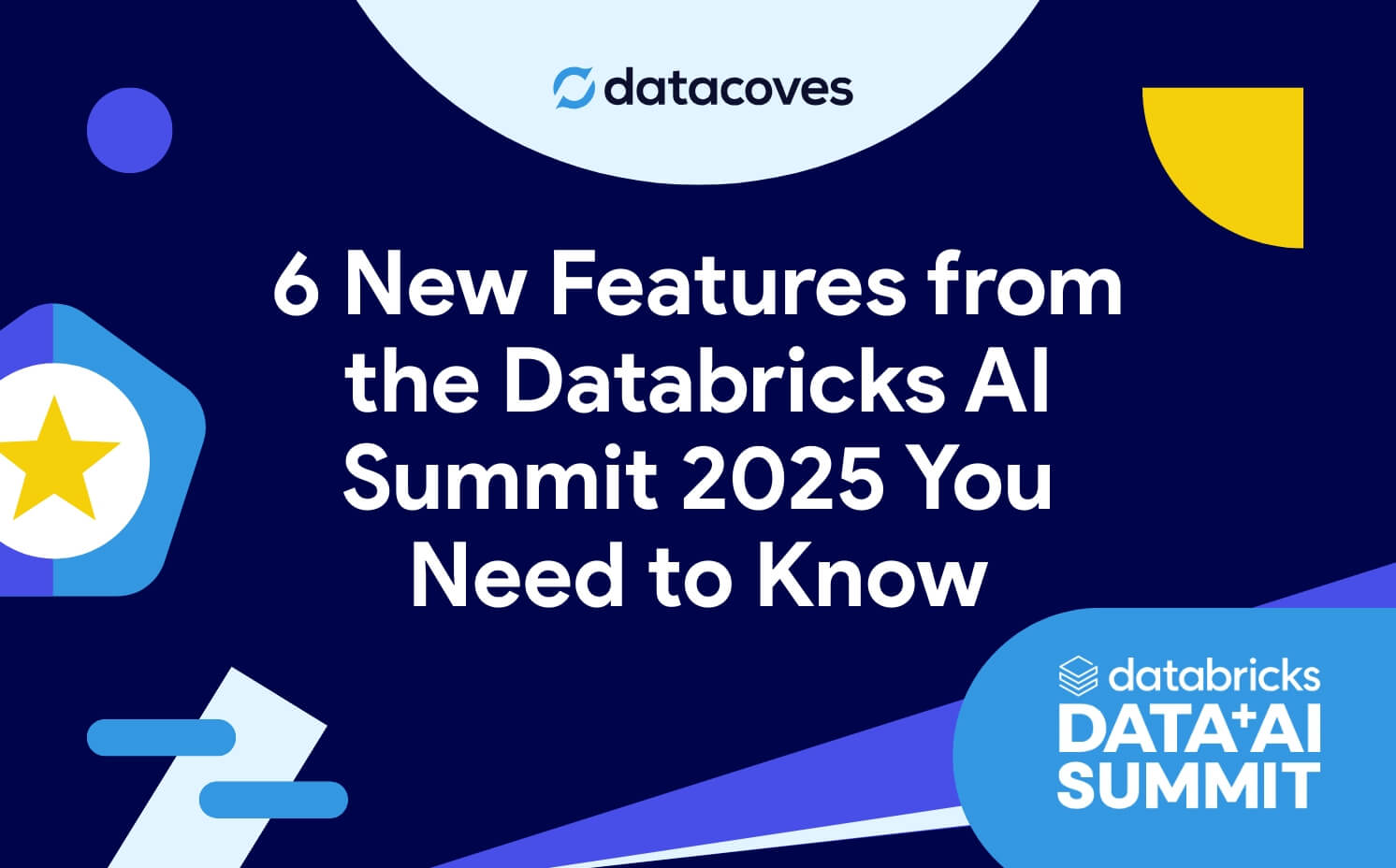
The Databricks AI Summit 2025 revealed a major shift toward simpler, AI-ready, and governed data platforms. From no-code analytics to serverless OLTP and agentic workflows, the announcements show Databricks is building for a unified future.
In this post, we break down the six most impactful features announced at the summit and what they mean for the future of data teams.
Databricks One (currently in private preview) introduces a no-code analytics platform aimed at democratizing access to insights across the organization. Powered by Genie, users can now interact with business data through natural language Q&A, no SQL or dashboards required. By lowering the barrier to entry, tools like Genie can drive better, faster decision-making across all functions.
Datacoves Take: As with any AI we have used to date, having a solid foundation is key. AI can not solve ambiguous metrics and a lack of knowledge. As we have mentioned, there are some dangers in trusting AI, and these caveats still exist.
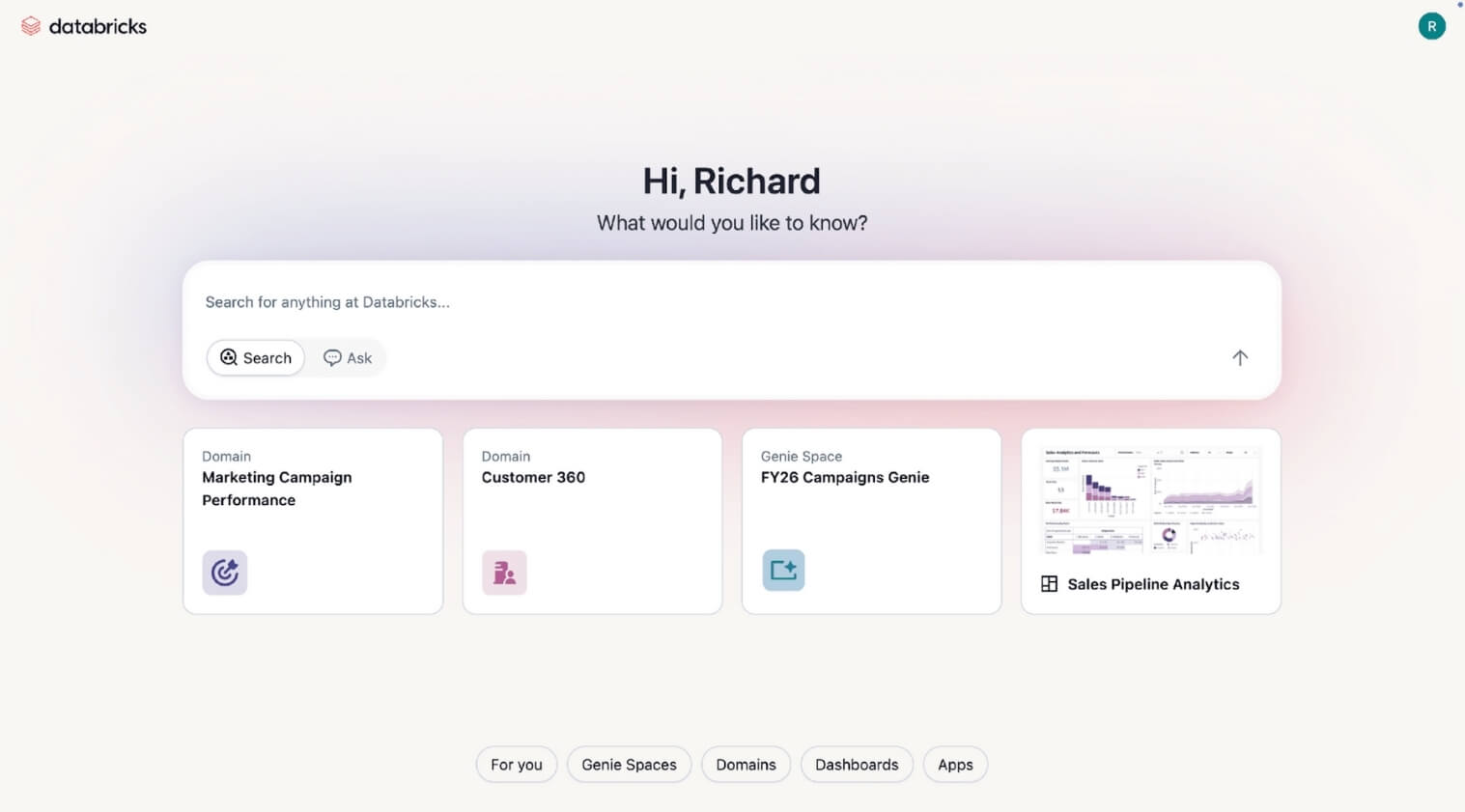
In a bold move, Databricks launched Lakebase, a Postgres-compatible, serverless OLTP database natively integrated into the lakehouse. Built atop the foundations laid by the NeonDB acquisition, Lakebase reimagines transactional workloads within the unified lakehouse architecture. This is more than just a database release; it’s a structural shift that brings transactional (OLTP) and analytical (OLAP) workloads together, unlocking powerful agentic and AI use cases without architectural sprawl.
Datacoves Take: We see both Databricks and Snowflake integrating Postgres into their offering. Ducklake is also demonstrating a simpler future for Iceberg catalogs. Postgres has a strong future ahead, and the unification of OLAP and OLTP seems certain.
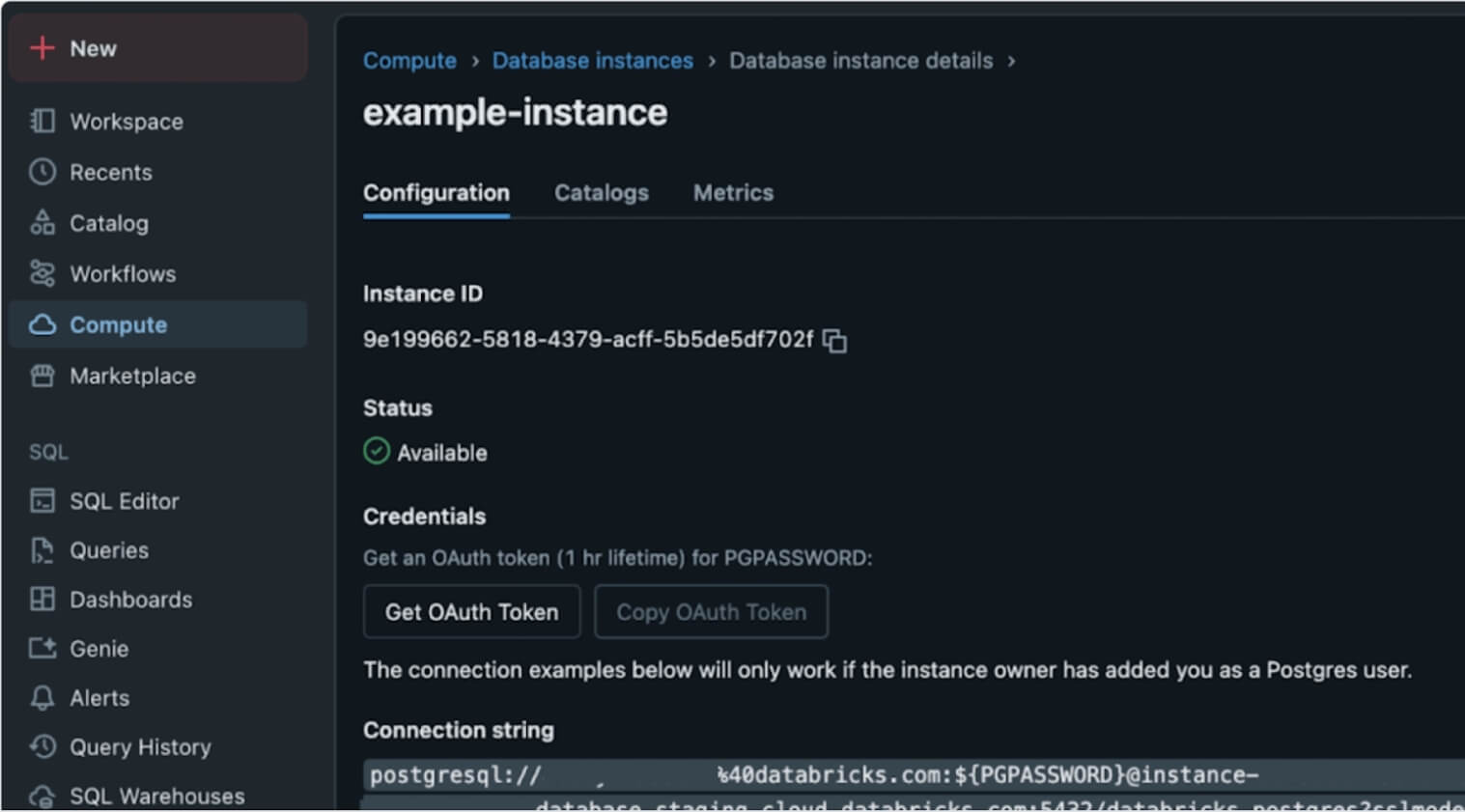
With the introduction of Agent Bricks, Databricks is making it easier to build, evaluate, and operationalize agents for AI-driven workflows. What sets this apart is the use of built-in “judges” - LLMs that automatically assess agent quality and performance. This moves agents from hackathon demos into the enterprise spotlight, giving teams a foundation to develop production-grade AI assistants grounded in company data and governance frameworks.
Datacoves Take: This looks interesting, and the key here still lies in having a strong data foundation with good processes. Reproducibility is also key. Testing and proving that the right actions are performed will be important for any organization implementing this feature.
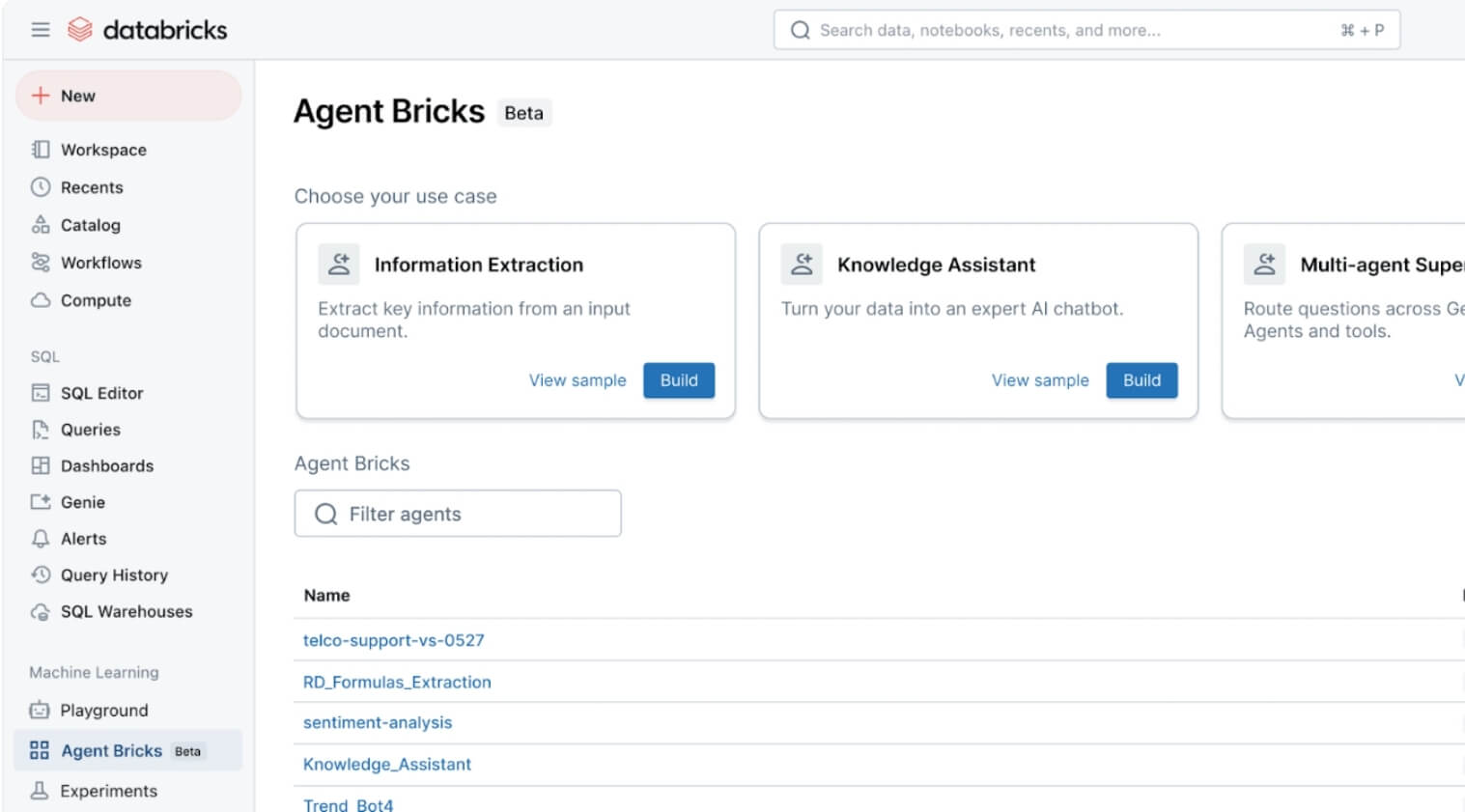
Databricks introduced Databricks Apps, allowing developers to build custom user interfaces that automatically respect Unity Catalog permissions and metadata. A standout demo showed glossary terms appearing inline inside Chrome, giving business users governed definitions directly in the tools they use every day. This bridges the gap between data consumers and governed metadata, making governance feel less like overhead and more like embedded intelligence.
Datacoves Take: Metadata and catalogs are important for AI, so we see both Databricks and Snowflake investing in this area. As with any of these changes, technology is not the only change needed in the organization. Change management is also important. Without proper stewardship, ownership, and review processes, apps can’t provide the experience promised.
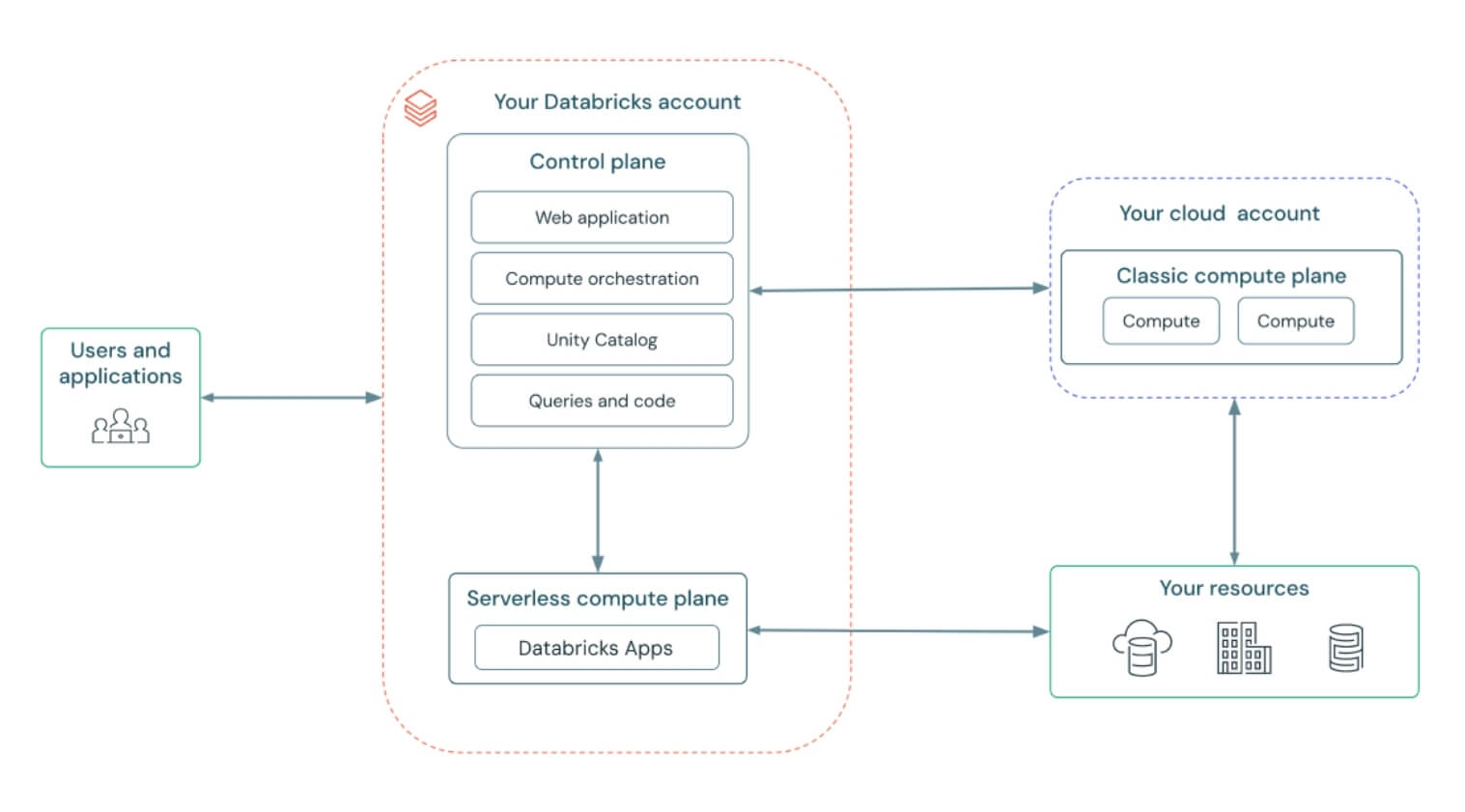
Unity Catalog took a major step forward at the Databricks AI Summit 2025, now supporting managed Apache Iceberg tables, cross-engine interoperability, and introducing Unity Catalog Metrics to define and track business logic across the organization.
This kind of standardization is critical for teams navigating increasingly complex data landscapes. By supporting both Iceberg and Delta formats, enabling two-way sync, and contributing to the open-source ecosystem, Unity Catalog is positioning itself as the true backbone for open, interoperable governance.
Datacoves Take: The Iceberg data format has the momentum behind it; now it is up to the platforms to enable true interoperability. Organizations are expecting a future where a table can be written and read from any platform. DuckLake is also getting in the game, simplifying how metadata is managed, and multi-table transactions are enabled. It will be interesting to see if Unity and Polaris take some of the DuckLake learnings and integrate them in the next few years.
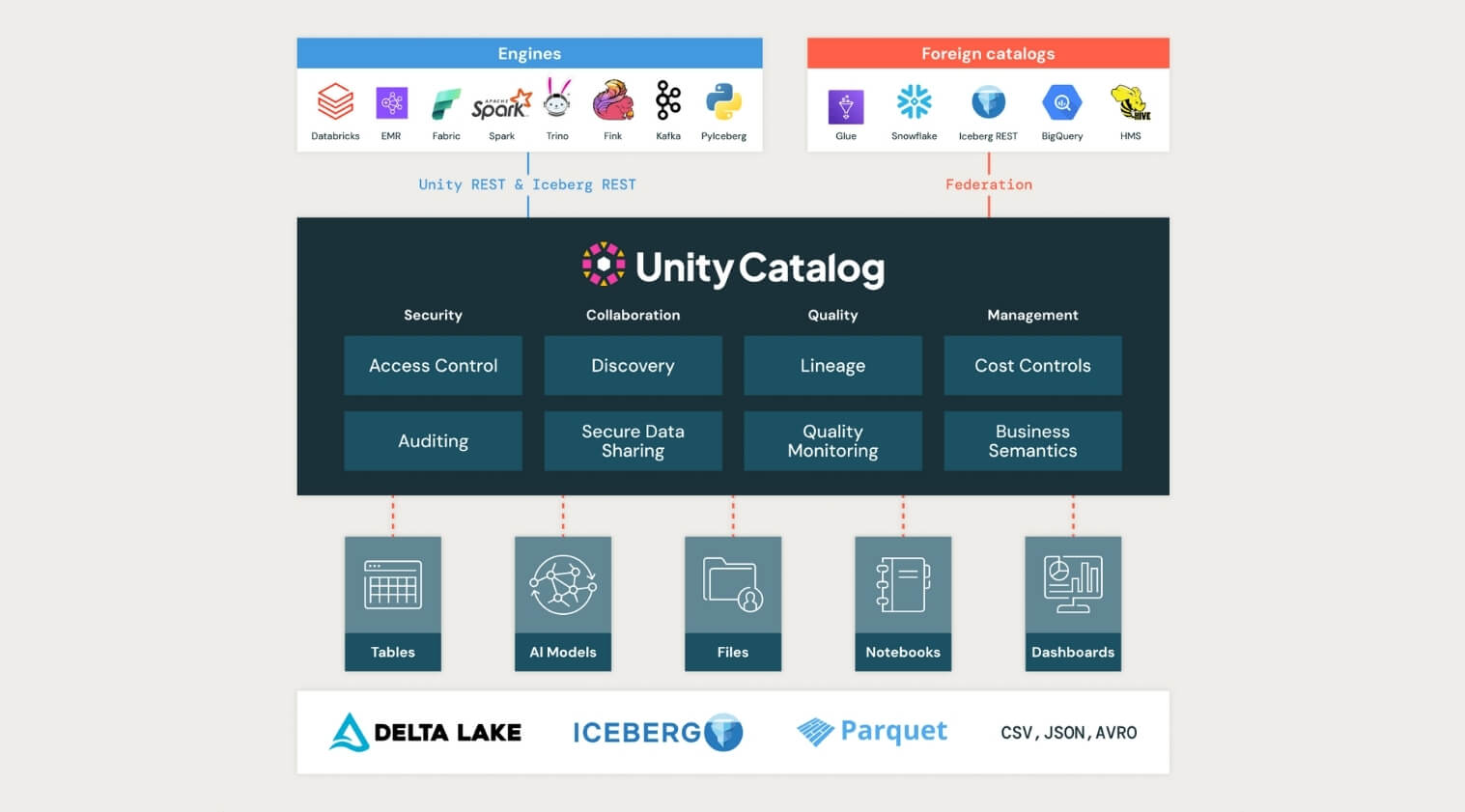
In a community-building move, Databricks introduced a forever-free edition of the platform and committed $100 million toward AI and data training. This massive investment creates a pipeline of talent ready to use and govern AI responsibly. For organizations thinking long-term, this is a wake-up call: governance, security, and education need to scale with AI adoption, not follow behind.
Datacoves Take: This feels like a good way to get more people to try Databricks without a big commitment. Hopefully, competitors take note and do the same. This will benefit the entire data community.
Read the full post from Databricks here:
https://www.databricks.com/blog/summary-dais-2025-announcements-through-lens-games
With tools like Databricks One and Genie enabling no-code, natural language analytics, data leaders must prioritize making insights accessible beyond technical teams to drive faster, data-informed decisions at every level.
Lakebase’s integration of transactional and analytical workloads signals a move toward simpler, more efficient data stacks. Leaders should rethink their architectures to reduce complexity and support real-time, AI-driven applications.
Agent Bricks and built-in AI judges highlight the shift from experimental AI agents to production-ready, measurable workflows. Data leaders need to invest in frameworks and governance to safely scale AI agents across use cases.
Unity Catalog’s expanded support for Iceberg, Delta, and cross-engine interoperability emphasizes the need for unified governance frameworks that handle diverse data formats while maintaining business logic and compliance.
The launch of a free tier and $100M training fund underscores the growing demand for skilled data and AI practitioners. Data leaders should plan for talent development and operational readiness to fully leverage evolving platforms.
The Databricks AI Summit 2025 signals a fundamental shift: from scattered tools and isolated workflows to unified, governed, and AI-native platforms. It’s not just about building smarter systems; it’s about making those systems accessible, efficient, and scalable for the entire organization.
While these innovations are promising, putting them into practice takes more than vision; it requires infrastructure that balances speed, control, and usability.
That’s where Datacoves comes in.
Our platform accelerates the adoption of modern tools like dbt, Airflow, and emerging AI workflows, without the overhead of managing complex environments. We help teams operationalize best practices from day one, reducing total cost of ownership while enabling faster delivery, tighter governance, and AI readiness at scale. Datacoves supports Databricks, Snowflake, BigQuery, and any data platform with a dbt adapter. We believe in an open and interoperable feature where tools are integrated without increasing vendor lock-in. Talk to us to find out more.
Want to learn more? Book a demo with Datacoves.

It is clear that Snowflake is positioning itself as an all-in-one platform—from data ingestion, to transformation, to AI. The announcements covered a wide range of topics, with AI mentioned over 60 times during the 2-hour keynote. While time will tell how much value organizations get from these features, one thing remains clear: a solid foundation and strong governance are essential to deliver on the promise of AI.
Conversational AI via natural language at ai.snowflake.com, powered by Anthropic/OpenAI LLMs and Cortex Agents, unifying insights across structured and unstructured data. Access is available through your account representative.
Datacoves Take: Companies with strong governance—including proper data modeling, clear documentation, and high data quality—will benefit most from this feature. AI cannot solve foundational issues, and organizations that skip governance will struggle to realize its full potential.
An AI companion for automating ML workflows—covering data prep, feature engineering, model training, and more.
Datacoves Take: This could be a valuable assistant for data scientists, augmenting rather than replacing their skills. As always, we'll be better able to assess its value once it's generally available.
Enables multimodal AI processing (like images, documents) within SQL syntax, plus enhanced Document AI and Cortex Search.
Datacoves Take: The potential here is exciting, especially for teams working with unstructured data. But given historical challenges with Document AI, we’ll be watching closely to see how this performs in real-world use cases.
No-code monitoring tools for generative AI apps, supporting LLMs from OpenAI (via Azure), Anthropic, Meta, Mistral, and others.
Datacoves Take: Observability and security are critical for LLM-based apps. We’re concerned that the current rush to AI could lead to technical debt and security risks. Organizations must establish monitoring and mitigation strategies now, before issues arise 12–18 months down the line.
Managed, extensible multimodal data ingestion service built on Apache NiFi with hundreds of connectors, simplifying ETL and change-data capture.
Datacoves Take: While this simplifies ingestion, GUI tools often hinder CI/CD and code reviews. We prefer code-first tools like DLT that align with modern software development practices. Note: Openflow requires additional AWS setup beyond Snowflake configuration.
Native dbt development, execution, monitoring with Git integration and AI-assisted code in Snowsight Workspaces.
Datacoves Take: While this makes dbt more accessible for newcomers, it’s not a full replacement for the flexibility and power of VS Code. Our customers rely on VS Code not just for dbt, but also for Python ingestion development, managing security as code, orchestration pipelines, and more. Datacoves provides an integrated environment that supports all of this—and more. See this walkthrough for details: https://www.youtube.com/watch?v=w7C7OkmYPFs
Read/write Iceberg tables via Open Catalog, dynamic pipelines, VARIANT support, and Merge-on-Read functionality.
Datacoves Take: Interoperability is key. Many of our customers use both Snowflake and Databricks, and Iceberg helps reduce vendor lock-in. Snowflake’s support for Iceberg with advanced features like VARIANT is a big step forward for the ecosystem.
Custom Git URLs, Terraform provider now GA, and Python 3.9 support in Snowflake Notebooks.
Datacoves Take: Python 3.9 is a good start, but we’d like to see support for newer versions. With PyPi integration, teams must carefully vet packages to manage security risks. Datacoves offers guardrails to help organizations scale Python workflows safely.
Define business metrics inside Snowflake for consistent, AI-friendly semantic modeling.
Datacoves Take: A semantic layer is only as good as the underlying data. Without solid governance, it becomes another failure point. Datacoves helps teams implement the foundations—testing, deployment, ownership—that make semantic layers effective.
Hardware and performance upgrades delivering ~2.1× faster analytics for updates, deletes, merges, and table scans.
Datacoves Take: Performance improvements are always welcome, especially when easy to adopt. Still, test carefully—these upgrades can increase costs, and in some cases existing warehouses may still be the better fit.
Free, automated migration of legacy data warehouses, BI systems, and ETL pipelines with code conversion and validation.
Datacoves Take: These tools are intriguing, but migrating platforms is a chance to rethink your approach—not just lift and shift legacy baggage. Datacoves helps organizations modernize with intention.
Enrich native apps with real-time content from publishers like USA TODAY, AP, Stack Overflow, and CB Insights.
Datacoves Take: Powerful in theory, but only effective if your core data is clean. Before enrichment, organizations must resolve entities and ensure quality.
Internal/external sharing of AI-ready datasets and models, with natural language access across providers.
Datacoves Take: Snowflake’s sharing capabilities are strong, but we see many organizations underutilizing them. Effective sharing starts with trust in the data—and that requires governance and clarity.
Developers can build and monetize Snowflake-native, agent-driven apps using Cortex APIs.
Datacoves Take: Snowflake has long promoted its app marketplace, but adoption has been limited. We’ll be watching to see if the agentic model drives broader use.
Versioning, permissions, app observability, and compliance badging enhancements.
Datacoves Take: We’re glad to see Snowflake adopting more software engineering best practices—versioning, observability, and security are all essential for scale.
Auto-scaling warehouses with intelligent routing for performance optimization without cost increases.
Datacoves Take: This feels like a move toward BigQuery’s simplicity model. We’ll wait to see how it performs at scale. As always, test before relying on this in production.
Enhanced governance across Iceberg tables, relational DBs, dashboards, with natural-language metadata assistance.
Datacoves Take: Governance is core to successful data strategy. While Horizon continues to improve, many teams already use mature catalogs. Datacoves focuses on integrating metadata, ownership, and lineage across tools—not locking you into one ecosystem.
Trust Center updates, new MFA methods, password protections, and account-level security improvements.
Datacoves Take: The move to enforce MFA and support for Passkeys is a great step. Snowflake is making it easier to stay secure—now organizations must implement these features effectively.
Upgrades to Snowflake Trail, telemetry for Openflow, and debug/monitor tools for Snowpark containers and GenAI agents/apps.
Datacoves Take: Observability is critical. Many of our customers build their own monitoring to manage costs and data issues. With these improvements, Snowflake is catching up—and Datacoves complements this with pipeline-level observability, including Airflow and dbt.
Read the full post from Snowflake here:
https://www.snowflake.com/en/blog/announcements-snowflake-summit-2025/

Not long ago, the data analytics world relied on monolithic infrastructures—tightly coupled systems that were difficult to scale, maintain, and adapt to changing needs. These legacy setups often resulted in operational bottlenecks, delayed insights, and high maintenance costs. To overcome these challenges, the industry shifted toward what was deemed the Modern Data Stack (MDS)—a suite of focused tools optimized for specific stages of the data engineering lifecycle.
This modular approach was revolutionary, allowing organizations to select best-in-class tools like Airflow for Orchestration or a managed version of Airflow from Astronomer or Amazon without the need to build custom solutions. While the MDS improved scalability, reduced complexity, and enhanced flexibility, it also reshaped the build vs. buy decision for analytics platforms. Today, instead of deciding whether to create a component from scratch, data teams face a new question: Should they build the infrastructure to host open-source tools like Apache Airflow and dbt Core, or purchase their managed counterparts? This article focuses on these two components because pipeline orchestration and data transformation lie at the heart of any organization’s data platform.
When we say build in terms of open-source solutions, we mean building infrastructure to self-host and manage mature open-source tools like Airflow and dbt. These two tools are popular because they have been vetted by thousands of companies! In addition to hosting and managing, engineers must also ensure interoperability of these tools within their stack, handle security, scalability, and reliability. Needless to say, building is a huge undertaking that should not be taken lightly.
dbt and Airflow both started out as open-source tools, which were freely available to use due to their permissive licensing terms. Over time, cloud-based managed offerings of these tools were launched to simplify the setup and development process. These managed solutions build upon the open-source foundation, incorporating proprietary features like enhanced user interfaces, automation, security integration, and scalability. The goal is to make the tools more convenient and reduce the burden of maintaining infrastructure while lowering overall development costs. In other words, paid versions arose out of the pain points of self-managing the open-source tools.
This begs the important question: Should you self-manage or pay for your open-source analytics tools?
As with most things, both options come with trade-offs, and the “right” decision depends on your organization’s needs, resources, and priorities. By understanding the pros and cons of each approach, you can choose the option that aligns with your goals, budget, and long-term vision.
A team building Airflow in-house may spend weeks configuring a Kubernetes-backed deployment, managing Python dependencies, and setting up DAG synchronizing files via S3 or Git. While the outcome can be tailored to their needs, the time and expertise required represent a significant investment.
Before moving on to the buy tradeoffs, it is important to set the record straight. You may have noticed that we did not include “the tool is free to use” as one of our pros for building with open-source. You might have guessed by reading the title of this section, but many people incorrectly believe that building their MDS using open-source tools like dbt is free. When in reality there are many factors that contribute to the true dbt pricing and the same is true for Airflow.
How can that be? Well, setting up everything you need and managing infrastructure for Airflow and dbt isn’t necessarily plug and play. There is day-to-day work from managing Python virtual environments, keeping dependencies in check, and tackling scaling challenges which require ongoing expertise and attention. Hiring a team to handle this will be critical particularly as you scale. High salaries and benefits are needed to avoid costly mistakes; this can easily cost anywhere from $5,000 to $26,000+/month depending on the size of your team.
In addition to the cost of salaries, let’s look at other possible hidden costs that come with using open-source tools.
The time it takes to configure, customize, and maintain a complex open-source solution is often underestimated. It’s not until your team is deep in the weeds—resolving issues, figuring out integrations, and troubleshooting configurations—that the actual costs start to surface. With each passing day your ROI is threatened. You want to start gathering insights from your data as soon as possible. Datacoves helped Johnson and Johnson set up their data stack in weeks and when issues arise, a you will need expertise to accelerate the time to resolution.
And then there’s the learning curve. Not all engineers on your team will be seniors, and turnover is inevitable. New hires will need time to get up to speed before they can contribute effectively. This is the human side of technology: while the tools themselves might move fast, people don’t. That ramp-up period, filled with training and trial-and-error, represents a hidden cost.
Security and compliance add another layer of complexity. With open-source tools, your team is responsible for implementing best practices—like securely managing sensitive credentials with a solution like AWS Secrets Manager. Unlike managed solutions, these features don’t come prepackaged and need to be integrated with the system.
Compliance is no different. Ensuring your solution meets enterprise governance requirements takes time, research, and careful implementation. It’s a process of iteration and refinement, and every hour spent here is another hidden cost as well as risking security if not done correctly.
Scaling open-source tools is where things often get complicated. Beyond everything already mentioned, your team will need to ensure the solution can handle growth. For many organizations, this means deploying on Kubernetes. But with Kubernetes comes steep learning curves and operational challenges. Making sure you always have a knowledgeable engineer available to handle unexpected issues and downtimes can become a challenge. Extended downtime due to this is a hidden cost since business users are impacted as they become reliant on your insights.
A managed solution for Airflow and dbt can solve many of the problems that come with building your own solution from open-source tools such as: hassle-free maintenance, improved UI/UX experience, and integrated functionality. Let’s take a look at the pros.
Using a solution like MWAA, teams can leverage managed Airflow eliminating the need for infrastructure worries however additional configuration and development will be needed for teams to leverage it with dbt and to troubleshoot infrastructure issues suck as containers running out of memory.
For data teams, the allure of a custom-built solution often lies in its promise of complete control and customization. However, building this requires significant time, expertise, and ongoing maintenance. Datacoves bridges the gap between custom-built flexibility and the simplicity of managed services, offering the best of both worlds.
With Datacoves, teams can leverage managed Airflow and pre-configured dbt environments to eliminate the operational burden of infrastructure setup and maintenance. This allows data teams to focus on what truly matters—delivering insights and driving business decisions—without being bogged down by tool management.
Unlike other managed solutions for dbt or Airflow, which often compromise on flexibility for the sake of simplicity, Datacoves retains the adaptability that custom builds are known for. By combining this flexibility with the ease and efficiency of managed services, Datacoves empowers teams to accelerate their analytics workflows while ensuring scalability and control.
Datacoves doesn’t just run the open-source solutions, but through real-world implementations, the platform has been molded to handle enterprise complexity while simplifying project onboarding. With Datacoves, teams don’t have to compromize on features like Datacoves-Mesh (aka dbt-mesh), column level lineage, GenAI, Semantic Layer, etc. Best of all, the company’s goal is to make you successful and remove hosting complexity without introducing vendor lock-in. What Datacove does, you can do yourself if given enough time, experience, and money. Finally, for security concious organizations, Datacoves is the only solution on the market that can be deployed in your private cloud with white-glove enterprise support.
Datacoves isn’t just a platform—it’s a partnership designed to help your data team unlock their potential. With infrastructure taken care of, your team can focus on what they do best: generating actionable insights and maximizing your ROI.
The build vs. buy debate has long been a challenge for data teams, with building offering flexibility at the cost of complexity, and buying sacrificing flexibility for simplicity. As discussed earlier in the article, solutions like dbt and Airflow are powerful, but managing them in-house requires significant time, resources, and expertise. On the other hand, managed offerings like dbt Cloud and MWAA simplify operations but often limit customization and control.
Datacoves bridges this gap, providing a managed platform that delivers the flexibility and control of a custom build without the operational headaches. By eliminating the need to manage infrastructure, scaling, and security. Datacoves enables data teams to focus on what matters most: delivering actionable insights and driving business outcomes.
As highlighted in Fundamentals of Data Engineering, data teams should prioritize extracting value from data rather than managing the tools that support them. Datacoves embodies this principle, making the argument to build obsolete. Why spend weeks—or even months—building when you can have the customization and adaptability of a build with the ease of a buy? Datacoves is not just a solution; it’s a rethinking of how modern data teams operate, helping you achieve your goals faster, with fewer trade-offs.

Organizations often opt for open-source tools because "free" seems like an easy decision, especially compared to the higher price of managed versions of the same tooling. However, as with many things, there is no such thing as a free lunch. When choosing these open-source tools, it is easy to say that the Airflow and dbt pricing is $0 dollars meaning a cost-saving choice, but hidden expenses that are hard to ignore will quickly be revealed.
dbt Core and Apache Airflow are a natural pair in modern data analytics. dbt Core simplifies SQL-based data transformations, empowering data teams to create and maintain clean, well-documented, structured pipelines. Apache Airflow takes care of orchestrating these workflows, automating the movement and processing of data through the data engineering life cycle. Together, they can drive a powerful analytics stack that’s flexible and scalable—when used correctly. But this flexibility often comes at a price.
In this article, we’ll examine the build vs. buy dilemma, highlighting the flexibility and true costs of open-source tools like dbt Core and Apache Airflow. We’ll also compare them to managed solutions such as dbt Cloud pricing and Datacoves pricing, providing the insights you need to evaluate the trade-offs and choose the best option for your organization.
The open-source tool dbt is free to download and use. However, the actual cost emerges when considering the technical resources required for effective implementation and management. Tasks such as setting up infrastructure, ensuring scalability, and maintaining the tool demand skilled engineers.
Assuming a team of 2–4 engineers is responsible for these tasks, with annual salaries ranging from $120,000 to $160,000 (approximately $10,000 to $13,000 per month), even dedicating 25–50% of their time to managing dbt Core results in a monthly cost of $5,000 to $26,000. As your use of dbt scales, you may need to hire a dedicated team to manage the open-source solution full-time, leading to costs equating to 100% of their combined salaries.
So we can begin to see the true open source dbt pricing, especially at scale. In addition to engineering labor are other costs such as time, and effort required to maintain and scale the platform. More on that later.
Just on engineering pricing alone, we begin to see the comparison between the open-source and managed solutions. dbt Labs offers a hosted solution, dbt Cloud, with added features and tiered pricing options.
Opting for a managed solution will allow your organization to cut engineering costs down or allow your engineers to focus on other projects. However, while dbt Cloud reduced the infrastructure burden a bit, it only focuses on the T of ELT. Meaning, you still need engineers to manage the other pieces of the stack which can result in a disconnected data pipeline.
It is worth noting that some companies decide to use dbt cloud for the scheduler feature which can quickly become limiting as workflows become more complex. The next step is always a full fledged orchestrator such as Airflow.
Just like dbt Core, Apache Airflow is also free to use, but the true cost comes from deploying and maintaining it securely and at scale, which requires significant expertise, particularly in areas like Kubernetes, dependency management, and high-availability configurations.
Assuming 2–4 engineers with annual salaries between $130,000 and $170,000 (around $11,000 to $14,000 per month) dedicate 25–50% of their time to Airflow, the monthly cost ranges from $5,500 to $28,000. The pattern we saw with dbt Core rings true here as well. As your workflows grow, hiring a dedicated team to manage Airflow becomes necessary, leading to costs equating to 100% of their salaries.
For teams looking to sidestep the complexities of managing Airflow in-house, managed solutions provide an appealing alternative:
A managed Airflow solution typically costs between $5,000 and $15,000 per year, depending on workload, resource requirements, and the number of Airflow instances. By choosing a managed solution, organizations can see cost savings in the infrastructure maintenance, overall maintenance stress and more.
Setting up and managing infrastructure for Airflow and dbt Core isn’t as straightforward—or as “free”—as it might seem. The day-to-day work from managing Python virtual environments, keeping dependencies in check, and tackling scaling challenges require ongoing expertise and attention. In addition to salaries and benefits, what starts as an open-source experiment can quickly morph into a significant operational overhead full of hidden costs. Let’s dive into how by looking at time and expertise, security and compliance, and scaling complexities which, if not considered, can lead to possible side effects such as extended downtime, security issues and more.
The time it takes to configure, customize, and maintain a complex open-source solution is often underestimated. It’s not until your team is deep in the weeds—resolving issues, figuring out integrations, and troubleshooting configurations—that the actual costs start to surface. With each passing day your ROI is threatened. You want to start gathering insights from your data as soon as possible. Datacoves helped Johnson and Johnson set up their data stack in weeks
And then there’s the learning curve. Not all engineers on your team will be senior, and turnover is inevitable. New hires will need time to get up to speed before they can contribute effectively. This is the human side of technology: while the tools themselves might move fast, people don’t. That ramp-up period, filled with training and trial-and-error, represents yet another hidden cost.
Security and compliance add another layer of complexity. With open-source tools, your team is responsible for implementing best practices—like securely managing sensitive credentials with a solution like AWS Secrets Manager. Unlike managed solutions, these features don’t come prepackaged and need to be built integrated with the system.
Compliance is no different. Ensuring your solution meets enterprise governance requirements takes time, research, and careful implementation. It’s a process of iteration and refinement, and every hour spent here is another hidden cost as well as risking security if not done correctly.
Scaling open-source tools is where things often get complicated. Beyond everything already mentioned, your team will need to ensure the solution can handle growth. For many organizations, this means deploying on Kubernetes. But with Kubernetes comes steep learning curves and operational challenges. Making sure you always have a knowledgeable engineer available to handle unexpected issues and downtimes can become a challenge. Extended downtime due to this is a hidden cost since business user are impacted as they become reliant on your insights.
Throughout this article, we have uncovered the true costs of open-source tools, bringing us to the critical decision between building in-house or buying a managed solution. Even after we have uncovered the actual cost of open-source, the decision isn’t just about price—it’s also about flexibility a custom build offers.
Managed solutions often adopt a one-size-fits-all approach designed to attract the widest range of customers. While this can simplify implementation for many organizations, it may not always meet the specific needs of your team. To make an informed decision, let’s examine the key advantages and challenges of each approach.
Pros:
Cons:
Example:
A team building Airflow in-house may spend weeks configuring a Kubernetes-backed deployment, managing Python dependencies, and setting up DAG synchronizing files via S3 or Git. While the outcome can be tailored to their needs, the time and expertise required represent a significant investment.
Pros:
Cons:
Example:
Using a solution like MWAA, teams can leverage managed Airflow eliminating the need for infrastructure worries however it may not have the flexibility or interoperability with other aspects of their stack
Whereas using a solution like Datacoves, teams can leverage managed Airflow and pre-configured environments for dbt Core. This eliminates the need for infrastructure setup, simplifies day-to-day operations, and allows teams to focus on deriving value from their analytics, not maintaining the tools that support them.
There is no universal right answer to the build vs. buy dilemma—every use case is unique. However, it’s important to recognize that many problems have already been solved. Unless there is a compelling reason to reinvent the wheel, leveraging existing solutions can save time, money, and effort.
In Fundamentals of Data Engineering, Joe Reis and Matt Housley emphasize the importance of focusing on delivering insights rather than getting entangled in the complexities of building and maintaining data infrastructure. They advocate for using existing solutions wherever possible to streamline processes and allow teams to concentrate on extracting value from data. The key question to ask is: Will building this solution provide your organization with a competitive edge? If the answer is no, it’s worth seeking out an existing solution that fits your needs. Managed platforms can reduce the need for dedicated personnel as we saw above and provide predictable costs, making them an attractive option for many teams.
This philosophy underpins why we built Datacoves. We believe data teams shouldn’t be bogged down by the operational complexities of tools like dbt and Airflow. And we also believe that Data teams should have access to the flexibility a custom-built solution has to offer. Datacoves offers the flexibility these tools are known for while removing the infrastructure burden, enabling your team to focus on what really matters: generating actionable insights that drive your organization forward.
Datacoves delivers the best of both worlds: the flexibility of a custom-built open-source solution combined with the rich features and zero-infrastructure maintenance of a managed platform—all with minimal vendor lock-in. How does Datacoves achieve this? By focusing on open-source tools and eliminating the burden of maintenance. Datacoves has already done the challenging work of identifying the best tools for the job, configuring them to work seamlessly together, and optimizing performance.
With Datacoves, your team can stop worrying about infrastructure and focus entirely on generating insights. The platform includes bundled in-browser VS Code, dbt Core, and Python extensions, alongside ready-to-use virtual environments tailored to analytics needs. Add to this a fully managed Airflow experience, and you have a solution where the code remains yours, but the operational headaches are gone.
Datacoves has enhanced Airflow with features designed to make DAG development more intuitive and enjoyable:
One of the key benefits of Datacoves is the elimination of hidden costs through its all-in-one platform approach. Teams often realize too late that piecing together the modern data stack—combining open-source tools, hosting solutions, and server infrastructure—results in unpredictable costs. A single misstep in configuration can lead to high cloud bills.
Datacoves removes the guesswork. Its optimized infrastructure provides predictable billing for non-variable services, along with clear guidelines for variable costs. By implementing best practices and optimizations, Datacoves ensures that your costs remain as low as possible without sacrificing performance.
Datacoves makes it easier for teams to harness the power of open-source tools like dbt and Airflow, without the operational burden. From simplifying complex workflows to delivering enterprise-grade infrastructure and predictable costs, Datacoves empowers teams to focus on what matters most: driving insights and business value.
Open-source tools like Airflow are incredibly powerful, offering flexibility and extensibility that modern analytics teams need. However, as we have seen, the initial appeal of "free" tools is not true. Actual costs exist in the form of salaries and benefits and hidden costs like costs of implementation, scaling, and long-term maintenance are very real and expensive. Paid solutions are around for a reason and finding the best one that suits your needs is essential.
If your team is looking to scale its analytics stack without the operational burden of managing open-source tools, Datacoves offers the perfect balance of flexibility, simplicity, and cost-efficiency. Explore Datacoves to learn more about our all-in-one platform for dbt Core and Airflow or check out our case studies and testimonials to see how other teams have accelerated their analytics engineering journey with Datacoves.

The reason companies fail at leveraging analytics stems from the fact that people tend to focus on the destination instead of the journey that will lead to the solutions that will have the most impact on the business. Time and time again, I see people focus on the so-called shiny objects, like new tools, new techniques, or even new people, that appear to be the silver bullet everyone needs. The truth is, if you go back to the first principles and start with true alignment, good data processes, and user-centric experiences, project success and satisfaction are achievable.
Every project I have been a part of started with a sense of optimism and excitement. The honeymoon phase was great. Everyone was united; we had gotten the funding, selected vendor partners, and purchased whatever technology was part of the solution. We all spoke the same language, everyone got to work, management started getting progress updates, and everyone thought we were off to a great start.
It wasn't until real decisions needed to be made that we realized the honeymoon was over. In every single instance, an excessive amount of time was spent in meetings arguing and reaching some level of consensus until the next decision. The reason this happened was because we didn't really spend the time to get on the same page. People assumed that we were aligned because at a high level, we all talking about the key points of the given initiative: digital transformation, self-service analytics, customer mastering, data lakes, etc.
But we were not really thinking the same things. Everyone had different backgrounds and had expertise on different parts of the solution: regulatory requirement, technology limitations, end-user needs, etc. There were also things no one knew at the start, and we didn't have a north star to guide these decisions. We all appeared to be saying the same things, but we were thinking very differently.

I have seen the pressure to get started on a project and show progress lead to delays and ultimate dissatisfaction with the end result. On projects where we have spent a couple of weeks getting aligned using a structured approach to product discovery, we ended up with better estimates and better overall satisfaction.
In any analytics-related project, the same things apply: the team needs to understand the business objectives, the current state (so the new process isn't worse), the risks, and prioritize the high-level features. Most importantly, the team needs to align on what's NOT in the new solution and the prioritizing criteria such as quality, feature completeness, or usability that will be used when making decisions. Agile does not mean no planning.
Trust starts by listening to people and creating a shared vision that sets the right expectations from day one. You can create an achievable plan if everyone knows what you are trying to achieve.
Let's face it, your data processes get no love. This is usually because this is "too technical." Your users don't care about databases, schemas, tables, or columns, let alone the process of converting raw facts into business-ready insights. It's easy for management to see a fancy dashboard and get excited about the possibility of machine learning, but talk about data and people's eyes gloss over.
It kind of makes sense; most people don't understand how the power grid works. We all take it for granted. We flip a switch, the light turns on, and we move forward. No one cares about electricity until something goes wrong. In a lot of organizations, things go wrong with data more often than you would think. Sometimes people notice right away, but other times failures are silent. When something does go wrong, everyone goes into firefighting mode. Meetings are held, issues are discovered, and patches to "prevent" the failure are put in place. The time to think about the inevitable is not once things break; you need to anticipate failure and design for resilience.
The issue here is that we don't think of the process of going from raw data to insights as a single system. It is all interconnected and needs to be treated as such. When it comes to analytics, sometimes it feels like companies want to build a mansion on a foundation atop quicksand. Initially, all seems fine, and everyone is in the house decorating until someone notices that a corner of the house is sinking. Everyone goes outside, props up the corner, and they happily go back inside to decide what color to paint the next room.
You can't build a house on quicksand; you need to set up repeatable processes with quality built in from the start. If we want collaboration, we have to build it in. If you want to be able to do impact analysis, guess what? You can't retrofit that later if you didn't do it from the start. Having documented analytics is not magic; you need this to be part of the culture and part of the process. The good thing is that many smart people have faced the same issues, and there are examples we can see where people are doing things right.
If you want users to trust data analytics, they need to trust the data, and they need to believe in a solid process that is built on a solid foundation.
When you try to please everyone, you please no one, and in many companies, technical teams try to do everything they are asked. They jump through hoops to deliver projects, but it is very common for people to be dissatisfied with the end results. I have also seen new tools used like old ones. Teams sometimes take the approach that the new process is just affecting some part of the current broken process, so they only incrementally change it. I have seen Tableau dashboards that are essentially Excel on the web with some automation.
Instead of asking users what they want, we need to understand what they need and why. What are they trying to accomplish? What's wrong with how they do things today? Is the new process / tool you are putting in place better than what they already have? Sometimes it makes more sense to leave a current process as-is until other parts of the system are improved.

When you understand the real need for an omni-channel dashboard or a sales dashboard, you design the solution to help you achieve that goal. If your users need to quickly get in and out of the tool, you can find ways to reduce the number of clicks it takes them to get there. You simplify access, and you surface the most important information first. You build the solution around them, and more importantly, you are able to justify your decisions and why certain things need to be de-prioritized. When users see that you empathize with them, they trust you. They don't push back on every choice because they know you have their best interests at heart because you have demonstrated time and again that you do care.
Getting decision-makers to trust data analytics is no different than getting anyone to trust anything. You need to start with alignment and set the right expectations; you need to build end-to-end processes that are robust; and you need to deliver the tools that facilitate the job users do.

Implementing dbt (data build tool) can revolutionize your organization's data maturity, however, if your organization is not ready to take advantage of the benefits of dbt it might not be the right time to start. Why? Because the success of data initiatives often hinges on aspects beyond the tooling itself.
Many companies rush into implementing dbt without assessing their organization’s maturity and this leads to poor implementation. The consequences that come from a poorly implemented dbt initiative can leave the organization frustrated, overwhelmed with technical debt, and wasted resources. To avoid these pitfalls and ensure your organization is truly ready for dbt, you should complete an assessment of your organization's readiness by answering the questions presented later in this article.
Before diving into the maturity assessment questions, it’s important to understand what data maturity means. Data maturity is the extent to which an organization can effectively leverage its data to drive business value. It encompasses multiple areas, including:
Data-Driven Culture: Fostering an environment where data is integral to decision-making processes.
Data Quality: Ensuring data is accurate, consistent, and reliable.
Data Governance: Implementing policies and procedures to manage data assets.
Data Integration: Seamlessly combining data from various sources for a unified view.
A mature data organization not only ensures data accuracy and consistency but also embeds data-driven decision-making into its core operations.
By leveraging dbt's features, organizations can significantly enhance their data maturity, leading to better decision-making, improved data quality, robust governance, and seamless integration. For example:

Data-Driven Culture: By using dbt, you can improve many aspects that contribute to creating a data-driven culture within an organization. One way is by encouraging business users to be involved in providing or reviewing accurate model and column descriptions which are embedded in dbt. You can also involve them in defining what data to test with dbt. Better Data Quality will improve trust in the data. More trust in the data will always lead to more frequent use and reliance on it.
Data Quality and Observability: dbt enables automated testing and validation of data transformations. This ensures data quality by catching issues like schema changes or data anomalies early in the pipeline. As your data quality and data observability needs grow you can assess where you are on the data maturity curve. For example, in a sales data model, we can write tests to ensure there are no negative order quantities and that each order has a valid customer ID. With dbt you can also understand data lineage and this can improve impact and root cause analysis when insights don’t seem quite right.
Data Governance: dbt facilitates version control and documentation for all transformations, enhancing transparency and accountability. Organizations can track changes to data models ensuring compliance with data governance policies.
Data Integration: dbt supports the integration of data from multiple sources by providing a framework for consistent and reusable transformations. This allows for the creation of unified data models that provide a holistic view of business operations.
Now that we understand what data maturity is and how dbt can help improve it, you might be ready to jump on the dbt bandwagon. But first, we encourage you to assess your organization’s readiness for dbt. The journey to data maturity involves not only choosing the right tools but also ensuring that your organization is philosophically and operationally prepared to take full advantage of these tools. It is important to recognize that dbt’s approach requires a shift in mindset towards modern data practices, emphasizing transparency, collaboration, and automation.
To determine if your organization is mature enough for dbt or if dbt is the right fit, consider the following assessment questions:
dbt requires a philosophical alignment with its principles, such as ELT (Extract, Load, Transform) instead of the traditional ETL (Extract, Transform, Load) approach. dbt is also based on idempotency meaning that given the same input, you will always get the same output. This is different than traditional ETL that may use incompatible constructs like Auto-Incrementing Primary Keys. If your organization prefers processes that are incompatible with dbt’s methodology, you will face challenges fighting the dbt framework to make it do something it was not intended to do.
Simply migrating existing processes and code to dbt without rethinking them won’t leverage dbt’s full potential. Assess whether you’re ready to redesign your workflows to take advantage of dbt’s capabilities such as incremental tables, snapshots, seeds, etc.
dbt offers excellent features for data quality and documentation. Evaluate if your team is prepared to prioritize the utilization of these features to enhance transparency and trust in your data. Tests and model descriptions will not write themselves. When it comes to good descriptions, they shouldn't come from a data engineering team that does not know how the data is used or the best data quality rules to implement. Good descriptions must involve business user review at a minimum.
The goal of dbt is to empower various teams including IT and business users by using the same tooling. Consider if your organization is ready to foster this cross-functional collaboration. When you implement dbt correctly, you will empower anyone who knows SQL to contribute. You can have multiple teams contribute to the insight delivery process and still ensure proper governance and testing before updating production.
Automation is key to achieving efficiency with dbt. Implementing automated deployment, testing, and CI/CD pipelines can significantly improve your workflows. If you aren’t ready to automate, the benefits of dbt may not be fully realized. If you simply put in dbt without thinking about the end-to-end process and the failure points, you will miss opportunities for errors. The spaghetti code you have today didn't happen just because you were not using dbt.
dbt is a framework, not a silver bullet. Merely changing tools without altering your underlying processes will not solve existing issues. This is a huge issue with organizations that have not done the work to create a data-driven culture. Assess if your team is ready to adopt better naming conventions and more structured processes to make data more understandable.
Data immaturity might manifest as a reliance on manual processes, lack of data quality controls, or poor documentation practices. These factors can derail the effective implementation of dbt since dbt thrives in environments where data practices are robust and standardized. In other words, dbt alone will not solve these problems.
Ensuring your organization is ready for the changes that come with implementing dbt is not just best practice, it is essential for success. By thoroughly assessing your readiness, you can avoid technical debt, optimize your workflows, and fully harness the power of dbt. Remember, dbt is a powerful tool, but its effectiveness depends on the readiness of your organization to improve data practices and its alignment with dbt’s philosophy.
